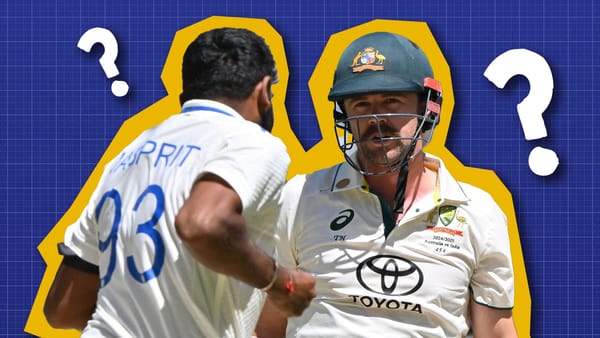How good is R Ashwin?
R Ashwin is the king of 5D cricket.

This piece was written before the news on Ashwin. Thoughts go out to him and his family at this time.
Mohammad Nawaz should not be bowling the 20th over of a T20 in Australia. It is a misuse of allocations. So his best chance of winning is trying to squeeze a ball into the pads, to give the batter no room. In front of him is not a specialist, just a bowler who bats. But when Nawaz goes for those pads, they aren’t there. The batter has moved them, he knew what was coming, and with two runs needed from one ball and hundreds of millions of people watching an India-Pakistan match, what does R Ashwin do? He leaves the ball.
The next delivery he wins the game with a lofted drive, and people still talk about the gutsy crazy Machiavellian leave. Even Ashwin said that if it went wrong, he might have retired on the spot.
Here we are talking about the last over of a T20 game where he left a ball, despite the fact we are celebrating the latest man to enter the 500 Test wicket club. But that last over leave is why Ashwin is so good.
Sure, we could tell you about something like when Ben Stokes attempts to block an Ashwin delivery that is full and flighted. He looks to defend it, but the ball turns, grips, and crashes into the off-stump- the classic off-spinner’s dismissal.
But this wasn’t something new. Ashwin eats the souls of left-handers He ends their bloodlines. This was the 12th time he dismissed the English skipper. His ability to dominate left-handers like no one else ever is incredible, but more predictable.
That isn’t what makes him remarkable, he is an off-spinner, so he is supposed to dominate left-handers. But what makes him great is how he thinks about every other part of cricket. R Ashwin is the king of 5D cricket.
And he used all those skills to take 500 wickets, the ninth person to do this in Test matches. That cements his greatness, but where does he rank among the legendary spinners and Indian bowlers of all time?

India have had great bowlers before, and Ashwin is not even the only one from India on the 500 club. But Ashwin stands out because he has the third-best average in this group of bowlers, and only Murali is ahead among the tweakers. Hell of a record.

With these many wickets at a great average, those who like huge totals will love him, but he also gives something to those who adore low bowling averages.

But, like Jimmy Anderson, questions persist. However, his record by venue country looks really good - an average of less than 25 in three countries and an average of under 30 in all but three. However, the home record here is definitely the standout. Australia and South Africa are the obvious ones to struggle with. But he’s an off-spinner, and plenty of great bowlers have done far worse in those kinds of conditions.

You can’t ignore Australia and England, two countries where he’s played a lot of his Test cricket. Any player from the big three spends so much of their time in this triangle, that it starts to define them.

This shows his genius so well. Lyon is a different kind of off-spinner, more plug-and-play. He will land the ball on the same spot with subtle changes and wait for the mistakes to come. Ashwin learned to be a hunter, upwind, in camouflage and controlling his breaths. His performances have gone from being significantly worse in the first tour, par in the next, and now much better in the last couple.

So while his overall record doesn’t look very flattering, Australia isn’t quite the best place to be if you’re an offie either. Ashwin wasn’t good in Australia, so he learned until he was better than Lyon. He will do the work.
In an interview with Cricket Monthly, he discussed planning for six months against Steve Smith and Marnus Labuschagne. He studied their batting styles closely and devised a plan for the Australian tour in 2020/21.
But then there’s England as well, his average looks good here without context. But his average of 33 against England in England looks good for a spinner in those conditions, his English counterparts have been better than him in these games.

Moeen Ali picked up 9 wickets in the Southampton Test in 2018. Ashwin took 3. India eventually lost the match by 60 runs. Harbhajan explained it, saying that Moeen’s side on action and pace variation helped him.
Is there something to be said for him looking at Australia as the big enemy, and maybe not preparing as much for England? So it could just be his version of magic doesn’t work as well there. But the WTC final in 2021 lowered his overall average in England to 28, and he also performed well in the County Championship.
But the fact he still does ok in England certainly lets you know he finds a way. And you look at his record outside of Asia, and there is an interesting trend. So against the southpaws, he's significantly better than against the right-handers. But in Asia, while he prefers the goofy-footed, he's ruthless against both batters. Put it this way, in Asia, he is a destroyer of worlds, in SENA, he’s a matchup beast.

But Ashwin is known for what he does inside India, he has the fifth-best average ever of all bowlers with 200 wickets at home. Some of that is combining Jadeja and a seam attack playing a solid support cast. With wickets are falling quickly from the other end, making it easier for him to pick fresh batters.

But it’s not just from playing on suitable wickets. His performances actually more than hold up when he’s playing on batting-friendly surfaces at home. When you can average 20 runs less than others on flat wickets, that is low-key supervillain.

The truth is that when conditions aren’t massively in his favour, he just activates a whole new level, like a jazz musician he promises until something sticks.
You are talking about a bowler who delivered around the wicket, and then ended the follow through by being over the wicket. He was running across the pitch, in front of the umpire to swap places. Why did he do this? To create a new angle the batter hadn’t faced before.
If anything, sometimes he improvises too much. There is so much going on in his head, but this is also the key to him being this good in the first innings of the match. If India bowl first, he is way better than other spinners.
By the second innings, he’s further in front. The other bowlers start to catch him at the end, even though he is still better. That part of the game is almost boring to him, just bowling on a spot, who wants that.

But for a normal spinner, that is where they eat, because they need the ball to be ragging to take control. Ashwin can still be a predator on flat wickets.
And if he can’t find a wicket normally, he will adapt to whatever he has too. He is an engineer, there is a crease, if you leave it, you are out. He sees cricket in code, he has no place for your earnest feelings or beloved spirits.
Think about his batting. Guys with this level of bowling talent don’t usually bat much. Ashwin has more hundreds than the other eight of the 500 club combined. Ashwin is not an allrounder, but he can certainly hold a bat and also gives a lot of utility with it.

Two of his most memorable batting performances came in 4th innings chases.
The first was at Sydney, where he partnered with Hanuma Vihari and stonewalled the Australian attack for 3 hours to draw the Test while nursing back pain. It was like watching an uncle with a hernia hold off an army.
The Mirpur innings was also significant. His partnership with Shreyas Iyer took India from home after they were 74/7 in a 145 chase.
The most interesting thing here is that both these results were important in context of the WTC final qualification.
However, his batting peak is long gone. He started as an opener in junior cricket. Till 2016 in Tests, his average was nearly 35. Ever since, it has nosedived to slightly more than 20. A lot of this is his movement has slowed. He was never an hard running high jumping athlete, but he doesn't have the flexibility he once had.

Although his overall average is slightly warped by the 10 not outs, he was a better Test batter than Jadeja at that point. But since 2017, Jadeja averages more than twice of what Ashwin does, and has been a regular at number six and seven with the bat.

In 2016 & 2017, Ashwin batted quite a few times in the top seven. India played all their games in Asia and the West Indies then. This allowed them to play five bowlers, even when India didn’t have Jadeja. At his best he really was an Asian conditions all rounder. Which again is incredibly handy.
So it’s pretty obvious that he prefers spin bowling. (If anyone should understand it, it should be him). But there is a noticeable gap in his average against the two bowling types. His lack of fast twitch movements probably also plays a part.

His record in and outside Asia also makes sense. Here is what I think is more interesting though, even away from Asia, he still finds a way. At home he’s low a low end allrounder, but away he’s a top-quality number eight.

This goes further right, even in T20, which would not normally suit his batting, he found a way to make an impact. By promoting him just to play spin, he either bats as the pinch hitter or blocker while moonlighting as an allrounder. Again, he isn’t one.
But that isn’t the point with Ashwin, it’s that he's willing to try anything to maximise himself in every situation.
Ashwin can take 500 wickets, with a low average, make five Test hundreds, pinch hit in T20 and can get run outs without delivering the ball. He is always in the game.
But we are talking about him because of the spin. And India have had great tweakers before. Bishen Bedi has a bowling average of 14.5 in the fourth innings, and he bowled lullabies with the ball. But as brilliant as the great man was, Ashwin on wickets and average really is something else.

What about Harbhajan Singh, the other great modern Indian off-spinner? He took a lot of wickets, but again his average was not really the same. One major differentiator has to be Harbhajan’s record at home. He was excellent till 2005, but then his record ballooned. Perhaps the pitches play a part here, but you can’t deny the fact that he wasn’t the same bowler anymore after 2005.

Now Ravi Jadeja enters the chat. His partner, and also the reason he hasn’t played as much away as we’d all have liked. Probably slowing down his development as a bowler (which is scary to think of). But while Jadeja takes him as an overall package, purely as a bowler, in terms of wickets, there is no real comparison.

Sir Ravi J still can catch the man who asked us not to call him Ravi. But that conversation is ongoing, and for now, the older man is in front.
That leaves us with Anil Kumble. He was basically R Ashwin before social media existed. Is Ashwin better than Kumble, all things considered? If we are constructing a Test side to play in Asia, and you only get one, picking Ashwin makes more sense with his batting.
But what about just as a bowler? In fact, to many, this entire conversation will seem ridiculous. Look at the difference of their averages.

But Anil Kumble was special. Of all the great post war spinners he is the one you'd probably back yourself to get through an over from. You wouldn't, but compared to Warne or Murali, you wouldn't be completely embarrassed either. You would miss the straight one though.
Were it not for his constant wipes at that sweaty forehead, you would wonder if he were truly a human. I mean, what sort of a spinner bowls that many balls on a good length, with grace, patience and no spin?
As a batter, you can understand, if not play, a freak like Warne or Murali. You are going up against their incredible physical gifts in a game of survival. They will keep you up at night in fear. You stay awake because of Kumble too, but because he’s already making you overthink.
As a batter your questions are, how do I keep missing the straight ones, and why does he only ever beat with me with a lack of spin. Facing Kumble was an existential threat to your stumps that became literal. You are trying to think of all the different things he can do, and then he bowls a straight one. While you are grappling with the true meaning of life, he’s appealing for another LBW.
It feels like Kumble played in another world. But remember he did take an extraordinary number of victims. Often on pitches that modern fans wouldn’t recognize as Indian.
So while most people would assume this is not even a conversation, Kumble should end up with more wickets. Although that is now in doubt.

So, let us dive deep. This is Kumble's record in India. We can see that he is also a fair bit better than the other Indian spinners he’s played with, like Harbhajan and Venkatapathy Raju. He's done much better than the touring tweakers in his era.

And you have to consider that this includes two of the greatest spinners in history - Warne and Murali. When you compare their records in the games they play against each other, it’s not even close. Kumble outbowls them by a mile when they come to India.


As great as Ashwin has been, he's also had top-notch support at the other end in the form of Ravi Jadeja and Axar Patel. None of the visiting spinners in India bar Lyon, Swann and Herath have been in that top tier. And even Herath has played only a couple of matches in the penultimate year of his career, where he bowled less than 50 overs combined.

We’ve talked about them in Australia, but it isn’t particularly close in India. Ashwin is much better, and the only time Lyon has a better average was in 2017. He does become better in 2023, but Ash is on a whole other level by that point. Where the last parts of his soft-athleticism are matched with his supercomputer brain.

Ashwin was up against Swann just once in 2012, which also happens to be the last time a visiting side won a Test series in India. Although Ashwin was just starting out and it was the second time the English offie came to India, it wasn’t even close between the two.

Kumble did not have the luxury of being a support bowler in India's greatest seam attack for a significant part of his career. And he was usually paired with Harbhajan as the second spinner, who was good, but nothing like Ashwin’s support.

Take Ashwin’s team spin average with a pinch of salt (9 wickets @54, all these are part timers except Jadeja who has taken all of these wickets). Ash has 71 wickets, so he essentially plays as a lone spinner overseas except 4 Tests, where he’s paired with Jadeja.
Neither of them have been particularly impressive on the road as compared to Warne and Murali. But those two are GOATs.
Even if you look at Ashwin’s numbers in isolation since 2018 (which is when he got better), it coincides with the fact that India’s pace attack peaked in that time period. This suggests that support hasn’t been a huge problem for Ashwin on the road.

So Ashwin is much better than the average spinner in his era, compared to Kumble. But Kumble’s career also coincides with the two greatest spinners of all time.

The other spinners average in the mid-33s in the games Ashwin plays, while they average just a little above 40 in Kumble’s case. This tells you about the difference in their pitches.

When we look at the match factor, the difference is not as much. Kumble had to play on surfaces more difficult for the tweakers. This is probably the important metric, as it shows that when you factor in pitches, Ashwin was better, but not by that much.

The truth is, you need an Ashwin-level mind to really look at the records of these two. When he retires he might write a thesis on where he rates on India, and the world’s all-time list. But he is at least in the top two for India, and he is not finished.
And because of who he is, we sometimes overemphasize the brain and left-field tendencies. But when it comes down to it, just as a pure off-spinner, he is about as good as we have ever seen. Flight, drift, accuracy and spin are all there.
But even when he looks normal, we know that what lies beneath is someone desperate to so things that no one ever has before. And looking at his career, he probably has.





